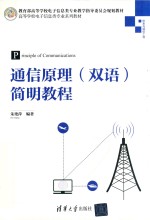

通信原理双语简明教程PDF电子书下载
- 电子书积分:10 积分如何计算积分?
- 作 者:朱艳萍编著
- 出 版 社:北京:清华大学出版社
- 出版年份:2019
- ISBN:9787302520573
- 页数:210 页
Chapter 1 Introduction 1
1.1 Basic concepts and models of communication system 2
1.1.1 Communication system model 2
1.1.2 Analog communication model 2
1.1.3 Digital communication model 3
1.2 The classification of communication systems 4
1.2.1 Modulation mode 4
1.2.2 Division of frequency band 5
1.3 Information and its measurement 6
1.4 The main performance index of communication systems 7
Summary and discussion 8
Homework 9
Vocabulary 9
Chapter 2 Random processes 11
2.1 Basic concepts of random processes(Definition of random processes) 12
2.1.1 Definition 12
2.1.2 Numerical characteristics of a random process 13
2.2 Stationary Random Process 14
2.2.1 Definition 14
2.2.2 Ergodicity 15
2.2.3 Autocorrelation function of stationary random processes 17
2.2.4 Power Spectral Density 17
2.3 Gaussian process 19
2.4 Transmission of a random process through a Linear Time-Invariant (LTI)filter 21
2.5 Narrowband random process 23
2.6 Sine wave plus narrowband Gaussian noise 26
2.7 Gaussian white noise and band pass white noise 27
Summary and discussion 29
Homework 30
Vocabulary 31
Chapter 3 Channel 32
3.1 The classification of channels 33
3.1.1 Wireless channels 33
3.1.2 Wire channel 34
3.2 Channel models 35
3.2.1 Modulation channel model(调制解调模型) 35
3.2.2 Coding channel model(编码信道模型) 36
3.3 Influence of the channel characteristics on transmission (for modulation model) 37
3.3.1 Influence of constant parameter channel on signal transmission 37
3.3.2 Influence of random parameter channel of signal transmission 37
3.4 Channel capacity (continuous channel) 40
Summary and discussion 41
Homework 42
Vocabulary and terminologies 42
Chapter 4 Continuous-wave modulation (Analog modulation system) 43
4.1 Introduction 43
4.2 Linear modulation 44
4.2.1 AM 45
4.2.2 Double-Sideband Modulation 46
4.2.3 Single-Sideband Modulation 47
4.2.4 Vestigial Sideband Modulation 49
4.3 Anti-noise performance of linear demodulation 51
4.3.1 Noise in linear receiver using coherent detection 52
4.3.2 Noise in AM receivers using envelope detection 54
Homework (part 1) 57
4.4 Angle modulation (Non-linear modulation process) 58
4.4.1 Basic definitions 58
4.4.2 NBFM(窄带调频) 60
4.4.3 Wide-band frequency modulation (WBFM) 61
4.4.4 Generating an FM signal 62
4.4.5 Demodulation of FM signals 63
4.4.6 Noise in FM receivers 64
4.5 Frequency-division multiplexing(频分复用) 66
Summary and discussion 67
Homework (part 2) 68
Terminologies 68
Chapter 5 Pulse modulation 69
5.1 Sampling process 70
5.2 Analog pulse modulation(模拟脉冲调制) 72
5.3 Quantization process(量化过程)of sampled signal 74
5.3.1 Uniform quantization(均匀量化) 75
5.3.2 Nonuniform quantization 76
5.4 PCM (Pulse code modulation,脉冲编码调制) 78
5.4.1 The principle of PCM 78
5.4.2 Noise in PCM system 79
5.4.3 Delta modulation(增量调制) 80
5.4.4 DPCM (Differential pulse code modulation,差分脉冲调制) 82
5.5 TDM(Time-Division Multiplexing,时分复用) 82
Summary and discussion 84
Homework 84
Terminologies 85
Chapter 6 Baseband pulse transmission 86
6.1 Waveform and frequency characteristics of baseband digital signal 87
6.1.1 Waveform of baseband digital signal 87
6.1.2 Symbol code types of baseband digital signals for transmission 88
6.1.3 Frequency characteristic 89
6.2 Matched filter 91
6.3 Error rate due to noise 93
6.3.1 Binary polar baseband system 93
6.3.2 The unipolar baseband system 94
6.4 Intersymbol Interference 95
6.4.1 Nyquist’s criterionⅠ 96
6.4.2 Nyquist’s criterionⅡ 98
6.5 Eye pattern 100
Summary and discussion 101
Homework 101
Terminologies 102
Chapter 7 Passband data transmission (Digital passband transmission) 103
7.1 The basic principle of three digital passband modulation 104
7.1.1 ASK 104
7.1.2 FSK 106
7.1.3 PSK(Absolute phase shift keying) 108
7.1.4 DPSK (Differential PSK) 110
7.2 Anti-noise performance of digital passband modulation system 111
7.2.1 Bit error rate of ASK 111
7.2.2 Bit error rate of 2FSK 112
7.2.3 Bit error rate of PSK 114
7.2.4 Performance comparison of digital keying transmission system 115
7.3 Hybrid amplitude/phase modulation schemes 116
7.4 OFDM system 117
Summary and discussion 118
Homework 119
Terminologies 120
Chapter 8 Further reading:new technologies in communication systems 121
8.1 Compressive sensing (CS) 121
8.1.1 Introduction 121
8.1.2 The mathematics theory 122
8.1.3 Application 124
8.2 Ultra wideband (UWB) system 126
8.2.1 The definition of UWB 126
8.2.2 Comparison with other wireless communications 127
8.2.3 Feature of UWB 127
8.2.4 Impulse modulation signal in UWB signal 128
8.2.5 The application of UWB 129
8.3 MIMO technology 130
8.3.1 The model of MIMO 131
8.3.2 Applications 132
References of Chapter 8 135
附录A MATLAB仿真实验 136
Experiment 1 Continuous-wave modulation (Corresponding to Chapter 4) 136
Experiment 2 Pulse modulation (Corresponding to Chapter 5) 148
Experiment 3 Digital passband transmission (Corresponding to Chapter 7) 160
附录B 实验箱实验 181
实验一 各种模拟信号源实验 181
实验二 脉冲编码调制PCM 185
实验三 AMI/HDB 3 编码和译码过程实验 192
实验四 FSK调制解调实验 197
实验五 通信系统综合实验 202
附录C 误差函数表 207
参考文献 210
- 《高级英语阅读与听说教程》刘秀梅编著 2019
- 《看图自学吉他弹唱教程》陈飞编著 2019
- 《激光加工实训技能指导理实一体化教程 下》王秀军,徐永红主编;刘波,刘克生副主编 2017
- 《AutoCAD 2019 循序渐进教程》雷焕平,吴昌松,陈兴奎主编 2019
- 《少儿电子琴入门教程 双色图解版》灌木文化 2019
- 《Photoshop CC 2018基础教程》温培利,付华编著 2019
- 《剑桥国际英语写作教程 段落写作》(美)吉尔·辛格尔顿(Jill Shingleton)编著 2019
- 《英语自学进阶教程全6册 3》爱尔兰迪尔德丽出版社著 2019
- 《雅马哈管乐队训练教程 降E调单簧管 分谱》Japan Band Clinic委员会 2019
- 《卓有成效的管理者 中英文双语版》(美)彼得·德鲁克许是祥译;那国毅审校 2019
- 《市政工程基础》杨岚编著 2009
- 《家畜百宝 猪、牛、羊、鸡的综合利用》山西省商业厅组织技术处编著 1959
- 《《道德经》200句》崇贤书院编著 2018
- 《高级英语阅读与听说教程》刘秀梅编著 2019
- 《计算机网络与通信基础》谢雨飞,田启川编著 2019
- 《看图自学吉他弹唱教程》陈飞编著 2019
- 《法语词汇认知联想记忆法》刘莲编著 2020
- 《培智学校义务教育实验教科书教师教学用书 生活适应 二年级 上》人民教育出版社,课程教材研究所,特殊教育课程教材研究中心编著 2019
- 《国家社科基金项目申报规范 技巧与案例 第3版 2020》文传浩,夏宇编著 2019
- 《流体力学》张扬军,彭杰,诸葛伟林编著 2019
- 《大学计算机实验指导及习题解答》曹成志,宋长龙 2019
- 《指向核心素养 北京十一学校名师教学设计 英语 七年级 上 配人教版》周志英总主编 2019
- 《大学生心理健康与人生发展》王琳责任编辑;(中国)肖宇 2019
- 《大学英语四级考试全真试题 标准模拟 四级》汪开虎主编 2012
- 《大学英语教学的跨文化交际视角研究与创新发展》许丽云,刘枫,尚利明著 2020
- 《北京生态环境保护》《北京环境保护丛书》编委会编著 2018
- 《复旦大学新闻学院教授学术丛书 新闻实务随想录》刘海贵 2019
- 《大学英语综合教程 1》王佃春,骆敏主编 2015
- 《大学物理简明教程 下 第2版》施卫主编 2020
- 《指向核心素养 北京十一学校名师教学设计 英语 九年级 上 配人教版》周志英总主编 2019
